Open any 90’s gaming magazine and your eyes immediately fall upon two words next to a review: “genre: Shooter”. As time passes, certain genres rise in popularity spawning one imitator after another until eventually settling in the dust only for a new genre to take over.
Director Shinji Mikami (known from series like Resident Evil) sought to bring the slowly forgotten “Beat ‘em up” genre into the new age with Capcom’s release of God Hand in 2006. Despite its lackluster financial success, it inspired Mikami to helm another modern iteration of a forgotten genre. The classic arcade shooter. The Shoot ‘em up. The Shmup.

Genres give designers a basis for their vision and what to look out for. As such Mikami, now working at the newly formed Platinum Games, looked to modern shooters for inspiration. He quickly noted that they ‘lacked the speed’ of a Shmup, where you were always moving. He wished to break this established format.
That, and he wanted vindication. Mikami had attempted to revive the Shmup once before with P.N.03 back in 2003, which wasn’t that successful due to development problems. Now armed with a bigger budget and a more lenient deadline… it was time.
The time… for Vanquish.
ACT 1
Released in 2010, Vanquish’s gameplay should seem familiar to anyone who has played a Third-Person Shooter. You walk with the left stick, aim with the right, you can shoot, dodge, take cover, aim, throw grenades, upgrade weapons and more. Instead what stands out is the suit worn by protagonist Sam Gideon.
This ‘Action Reaction Suit’ runs on energy and can be used to slow down time, allowing players to shoot missiles out of the air with ease or score that critical headshot while under pressure. Once the heat is off you can pump the juice into your legs to boost across the screen and start a lightning fast offensive to finish them off. Push it too far however and the suit will overheat, slowing Sam’s dodge while also disabling abilities like the boost and time-slow until the suit cools down.
This risk-reward system quickly results in a constant mini-game of metermanagement during gameplay with you always pushing the suit to its limits, squeezing out just that little fraction of a second longer while at other times keeping a reserve in case you need to make a quick getaway during combat
Said fights take place in a pristine futuristic environment. Like the favored suit, the locales are white with small touches of green giving the feeling of a chrome-like future. In juxtaposition to these stand enemies with edgier designs embezzled with gold and red. As a result they immediately stand out making targets easy to spot; design supporting the gameplay.
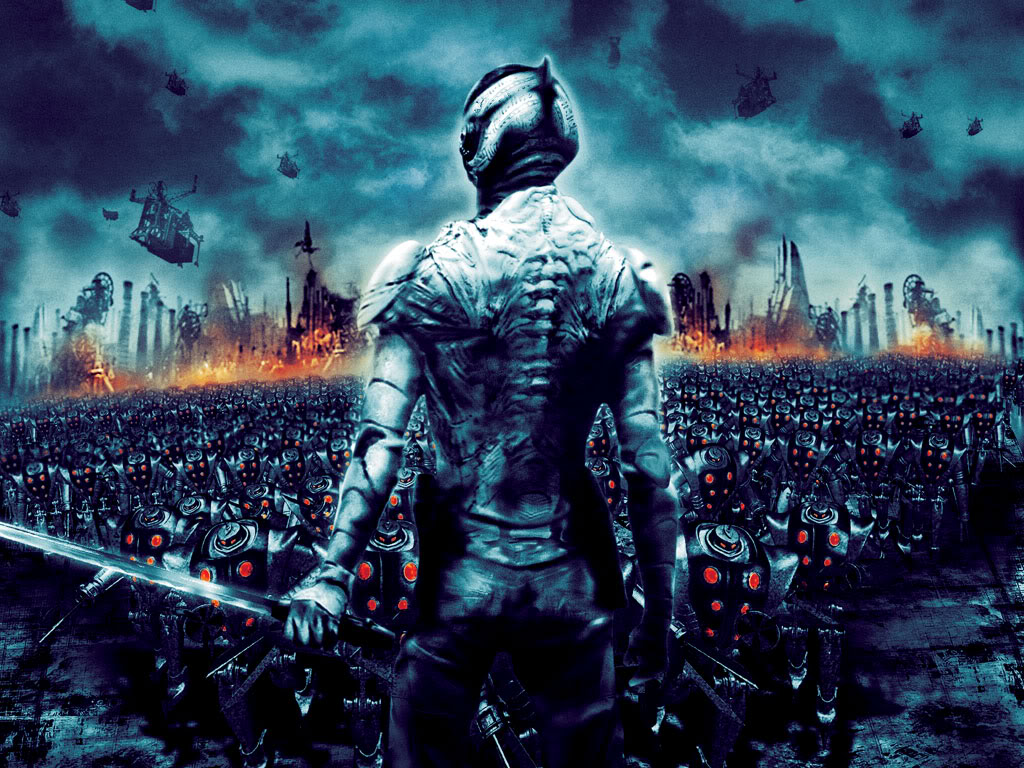
Casshern, the 2004 film 
Vanquish, the 2010 video-game
One of the inspirations of the game’s style was the film Casshern (キャシャーン, Kyashān), as shown above. Mikami noted he wanted to maintain Casshern’s “feeling of speed”, without making his fists of fury the mainstay, not wanting to create another God Hand. As such, melee attacks deal massive damage but drain the suit of all its juice, adding another layer of risk-rewards.
So far though, its quirk of metermanagement and speed aside, Vanquish sounds like a Third-Person Shooter. Yet upon release Vanquish was labeled as an “Action Shooter” by its developer and has since been enjoyed more by fans of the Action and Shmup genre than Shooter fans. How so? We can start our search for that answer by taking a deeper look at Vanquish’s enemies.
ACT 2
The foes fought in Vanquish vary from small droids named Gorgies who spurt binary as they’re about to lunge at you, large mechanoids called Romanovs that grunt as they activate their flamethrower, to an agile boss which warns you to “aim carefully” as he reveals his hidden weapon.
Each enemy has a tell and a purpose behind its moves. Some of them merely seek to distract you from the bigger threat while others try to slow you down by overheating you; removing randomness from attacks makes the player more aware of how the enemies work and how to counter them. These “tells” reward experienced players akin to how arcade Shmups of old would.
Shoot these foes and things start to change. Enemies don’t just stand there eating bullets until they explode; instead a shotgun blast sends smaller foes flying while tumbling bigger targets, giving you some breathing room. Striking a weakness makes enemies go berserk and if you deal enough damage to a single body part it will be removed entirely, changing enemies and their place in the battlefield altogether. Some might crawl towards you hoping for a kamikaze blow, while blinded enemies walk and shoot around aimlessly.
Sam’s weapons, like the Disc Launcher, make this task even easier by dismembering a limb in a single well placed shot. Meanwhile the Lock-on-Laser allows players new to shooters to hit their target while giving veteran players a weapon that can bend shots around cover.
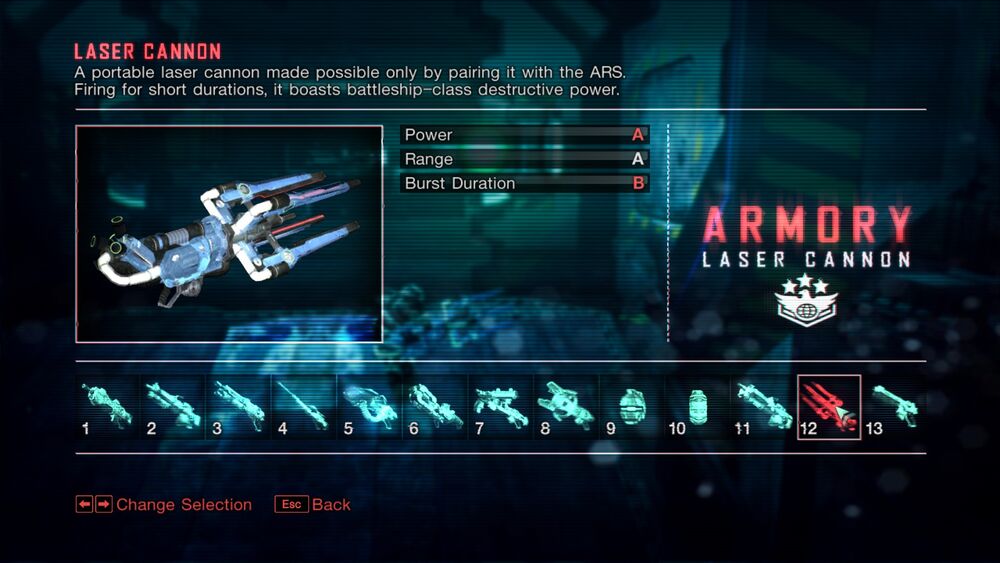
Other weapons are less unique, ranging from an accurate Assault Rifle, high damage Heavy Machine Gun, EMP grenades for stunning foes, Frag grenades to kill groups and the typical rocket launcher and shotgun which do what you’d expect.
Lastly though there’s the Low Frequency Energy Gun, or LFE for short, a weapon that fires a purple orb of force that travels through walls. While killing smaller enemies in its wake, its biggest application is in how it pushes things forward. One can use it to give your grenades a distance boost, push larger enemies off of cliffs or stunlock the biggest of the bad by constantly knocking them over. It really is a weapon whose limits are defined by player creativity and with each run you’ll be surprised to find new uses for it.
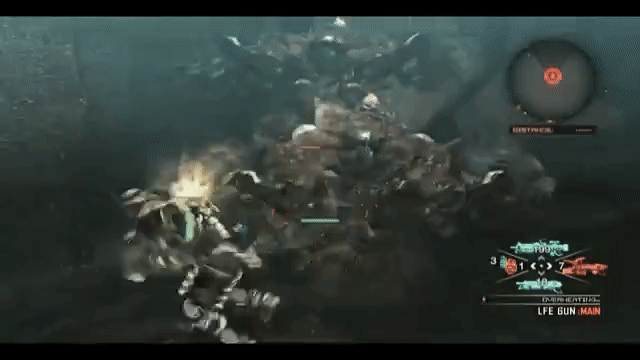
Vanquish’s core distinction then, beyond the speed, is that it isn’t about shooting an enemy until he dies. It is about using your tools in creative ways to dispatch them. An example: you could delimb or knock down the enemy to gain an advantage, all while managing the arena and – if one wishes it – show off by doing backflip and shooting a grenade out of the air while hanging airborne upside down using bullet-time. All elements from the Action genre, now being used in a Third-Person Shooter.
This is further enhanced by the presence of various tricks and abilities hidden from plain sight. Switching to a shotgun while firing your machine gun immediately cancels one shot into the next. Dropping an EMP grenade while boosting sets it off immediately instead of having to wait a few seconds. There are more neat tidbits like this that give players more to master in Vanquish’s fights than just their aim.
Throughout these fights you’ll often use your ability to slow down time to control the area. Compared to its contemporaries like Max Payne, you can only activate the slow-motion while dodging, boosting or after a dash-attack. As a result, unlike said contemporaries, Vanquish is thus less rewarding to play for players sticking in cover waiting to make a quick headshot.
Tying the slow-motion to movement abilities fits better with Vanquish’s design where mobility is the focus, akin to the Shmup where you were always moving automatically to begin with. In a sense, Vanquish evolves the Shmup into a 3d space where we move forward instead of the screen doing it for us while adding mechanics from action games past that fit flawlessly with it.
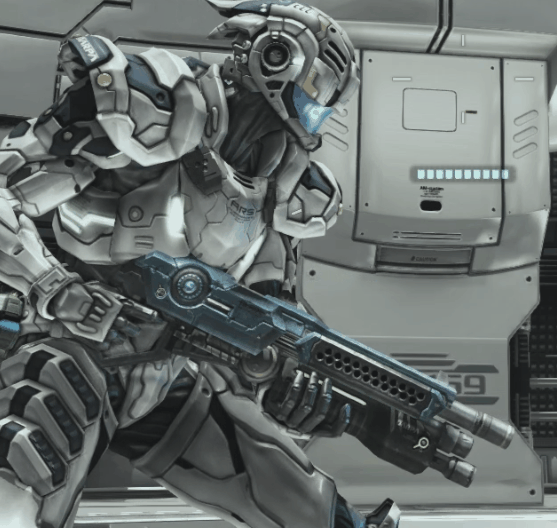
You can see this in the way Vanquish handles its cover system as well. With nearly all cover being destructible it makes it nothing more than a place to take a quick break, for example by having a smoke. After taking a whiff Sam throws the bud away, distracting enemies and allowing him to boost past. While it sounds like a fun roleplay feature, this mechanic is actually extremely powerful, allowing players to bypass entire sections if used smartly and promoting mobility once again.
In its attempts to merge a more action-philosophy with a Shooter basis, Vanquish does however stumble at times. It might be partially to blame on Japanese developers having very little experience with the genre compared to the West.
An example of such a stumble would be how Vanquish’s combat mostly takes place on a horizontal plane, rarely offering more vertical combat depth. Enemy weak spots are always on their back, never below or above them and the terrain rarely allows for combat on such an axis either.
There are rare occasions when it does try this by putting snipers on a catwalk for instance, but it never asks players to multitask enemies coming from below and above. This makes even these encounters feel horizontal. The target you are looking for is always in front of you and in clear view which could be due to the game’s roots as a console-Shooter.This is also evident in the speed at which enemies move. While playing with a controller you can keep up, but when played with a mouse and keyboard you’ll notice even the fastest enemies become easy targets. As such it is recommended you play with a controller even in the later PC release to play the game the way it was intended.
Likewise, its Shooter roots show through in terms of enemy compositions. Most Shooters sadly don’t offer much in terms of enemy variety and how they are composed together, with only a few exceptions and this carried over to Vanquish. While the game does experiment a bit with enemy compositions in its Challenge Maps, most fights in the campaign generally square you off against one enemy type supported by some goons that are easily dispatched of.
This lack of detail in the campaign is further noticed by its pacing. Instead of breaking up the shooting with parts of exploration or side-ventures the game features long stretches of combat only to suddenly be given a ton of turret sections or other off-beat sections in a row. Boss fights are rare but then at one point you fight two bosses in a row. Some other details that most shooters would nail are also absent, like the ability to easily shift between cover or switch shoulders when aiming.
ACT 3
Thankfully, as made clear before, the combat still has more than enough to counterbalance these shortcomings. Though… one’s mechanics are only as good as its motivator. You can have all the abilities in the world but if there isn’t something pushing players to reach those skies it might never come to fruition. For Vanquish this carrot on a stick seems absent at first, with no real unlockables, a more open ended score-system and a Hard mode that doesn’t really offer a challenge.
That is until one unlocks God Hard difficulty, what some might call the ultimate test.
In this mode all fallbacks are removed: dangerous foes appear sooner, upgrades are disabled and, most impactful, your meter drain is more than doubled. Add slower health regeneration, sturdier enemies, increased enemy aggression and no achievement as a reward and you’ve got a setting that is only for those that desire a challenge.
Rushing into a battle without preparation and not remembering what enemies were present can see you dead in seconds and enemies are relentless. No longer do they fire on your allies, you are now their absolute main target. It’s a form of brutality that urges players to master the game and to push Sam’s suit beyond its limits – to truly wear it. God Hard demands excellence and with every try you will look to improve.
Should you make it through you’ll eventually face off against the final challenge. The “Twin Bogeys”. Bogey Alpha and Bogey Bravo. “The run killers”.
They are two enemies whose mobility matches your own, who force you to prioritize targets, who can overheat your suit and attack you from multiple directions and even elevations. A boss fight that forces you to eye your suit’s meter even more. A fight where cover is constantly shifting, making movement key. All while still adhering to the laws of the game by being able to be staggered, stunned with EMPs or blasted apart with a well placed kick to their jetpack. They are dangerous, hit hard, but most of all give a tense and unforgettable fight. What makes them stand out is how it is the perfect amalgamation of everything the game wants you to do up until this point.
If you beat them, congratulations, for as noted there is no in-game reward. Looking at the leaderboards afterwards you’ll be greeted by a small list, some might even be nearly empty depending on what system you’re playing on.
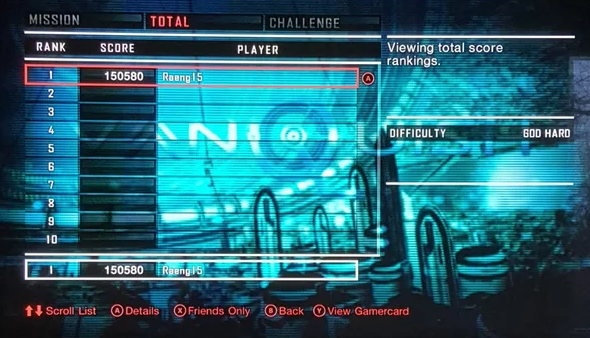
The true joy however is found afterwards in improving your score and by playing better. You can start relying less on cover, playing more on the offensive, managing your meter better, etcetera.
While your first run through God Hard might be one of hundreds of deaths, perhaps your next is only dozens, and your fifth only a few. Too often do players quit a game after beating a challenge by sheer dedication and time investment. God Hard however is challenging and fun in how it always stays hard but gives players the chance to improve their runs.
Vanquish’s entire design philosophy is built around replaying the game, not for a reward, but for enjoyment because the gameplay is just so well made.
ACT 4
And sadly, that was also what Vanquish received, no reward. While most critics spoke fondly of it on release for its high speed gameplay, many elements also played against it. This is because aside from inspiring design, genres can also work against a product. Genres play with expectations. When playing a stealth game players can expect a certain function like crouch to be present or for shadow to hide them. When it doesn’t they’ll be dismayed and may even dislike it outright, no matter the unique reasoning or mechanics on display.
In the case of Vanquish players saw the term “Shooter” and went in expecting it to play differently than it did. Both have cover systems, thus they’d have to work similarly. Right? Surely there’s multiplayer and co-op as well. Right? Confusion that resulted in a dissatisfied player base and bad word of mouth upon launch.
Consequently many fans of games like Ninja Gaiden and Devil May Cry also saw the term “Shooter” and as such skipped the title entirely, only picking it up when word of mouth from those adventurous few reached their ears.
The timing was also off. Vanquish launched just after the highly anticipated action title Castlevania: Lords of Shadow while also releasing on the same day as Fallout: New Vegas. This saw the game dip in price after less than four months.
Despite this, Vanquish slowly became something of a cult hit over the years. Its reputation also bloomed in short bursts when it was ported to PC, Xbox One and Playstation 4 down the line. Mikami’s desire to bring an old fashioned style of gaming into the modern era, mixing and mashing multiple current genres together, struck a chord with players.
Everything in Vanquish is in the service of its gameplay. To give the most pure and fun experience possible. The enemies look the way they do because of the gameplay, the coolest things that happen in the game are done by you during gameplay and it features a short campaign that begs to be replayed just because the combat is so enjoyable. Even its credit-sequence is pure gameplay.
After Vanquish’s release, Mikami left Platinum Games to start his own company once again. With another genre revived he set his goals to resurrect another from the dead. A genre that he felt was falling behind its potential, perhaps partially because of his own actions. A genre very close to him. How that story unfolds, will have to wait.
鑒 reflection style 鑒
In this short section I reflect on the article from my own viewpoints as a gamer and lover of the genre instead of a critic.
Originally I started this ‘reflection style’, called ‘opinion style’ at that point, by noting it was one of the most challenging pieces I had ever written due to how close I was to the game. What you read now was an extensive re-write, because upon re-reading this article years later I couldn’t believe the lacking quality. There’s a lot to be learned in writing a good review and I could clearly see I was still learning the ropes, finding it hard to juggle a theme while also analysing mechanics within a piece.
But why is Vanquish so special for me? Wouldn’t you say Ninja Gaiden is that, but moreso? While I think highly of Ninja Gaiden, I never finished any entry more than ten times. Vanquish on the other hand was a title that I finished more than forty times and counting with a new replay happening at least once or twice a year. And ever since I started Stinger Magazine I have kept notes of elements or minor grievances I had with the title but never dared structure them or write down because I was in too deep.
How I got into Vanquish is something I can’t quite recall. I had originally gotten Bayonetta as part of a subscription to an, admittedly, bad gaming magazine. I liked the title, beat it on the highest setting and earned the Platinum Trophy on the horrible Playstation 3 release. Some time later I think I noticed a heavily discounted Vanquish on a store shelf. I completed it in one single day and immediately delved into the Challenge Maps afterwards. I was stuck on Challenge 4 for two days; I remember walking through museums with classmates during the day while I thought up strategies. Challenge 6 took longer until I decided that that Saturday would be the day. I put on the song “You’re The Best Around” by Joe Esposito and went at it until it was done – and I did it. This situation would play out again exactly the same years later while doing a certain handicap-run of Metal Gear Rising: Revengeance. “God Hard” difficulty wasn’t finished until much later, during the PSN outage which forced me out of my online Street Fighter addiction.
Vanquish introduced me to many players I still talk to today and it is a title that gave me enough self-esteem to delve into other action titles like Ninja Gaiden and Devil May Cry where I met even more of those people. People that motivated me when I came to them years later with a review on Devil’s Third hosted on a blogspot account filled with typing mistakes. It is a game I will forever cherish and I pray I did it justice with this article. Originally I feel I didn’t, but now, I hope I did.
斬 postscript notes 斬
- The game is filled with Pangloss statues to ‘collect’ by shooting at them. Yet they do nothing, which I always found weird;
- I wanted to mention Challenge #6 in this article, but wanted to focus more on God Hard difficulty. Challenge #6 is equally brutal, perhaps moreso, and was absolutely destroyed by player MoluJPN;
- Later releases on both PC and Xbox One and PS4 ran on 60 frames per second compared to the original’s 30 frames per second, leading to a lot of errors. Even after numerous patches certain damage values and enemy aggression levels are not what they should be;
- One thing players might notice is just how low your score is and how high some on the leaderboards are. The scoring-system was built in memory of its arcade roots and aimed to reward fast players and punish deaths. Yet by pressing “return to title screen” at any time all recent mistakes since the last save are deleted. This turns score-runs into a scenario where a player presses restart until the perfect run is achieved instead of a tense experience where one mistake could mean the end. As such there are a ton of ‘no death runs’ of Vanquish online, yet no-one has actually done so as of writing;
- I once invited a friend over to play some games and he was visibly shocked to see Sam having a different animation when taking cover in a wall that is lower than chest-height. Rightfully so; it’s not something seen often;
- Vanquish actually had an official tournament held in Japan on who could beat the Challenges the fastest, even Inaba was present himself. You can read more about it here;
- I feel the jump from Hard to God Hard can be a bit too extreme at times. With Hard being so easy while God Hard adds so many new modifiers, one could question whether or not a difficulty should’ve been placed in between. On the flipside, the jump is precisely what makes it so appealing to some. Sadly, because the game lacks the motivation to use its mechanics early on, most players would have clung to a more defensive playstyle, hopping from cover to cover. A style of play that simply won’t see them survive in the hectic of God Hard difficulties’ earlier levels like ACT 1-3 where snipers, turrets, carrier ships and even large mecha Romanovs reign.
- The final boss of Vanquish is technically speaking just an earlier boss but now two of them; a design choice Mikami would later reuse in The Evil Within;
- Killing about 40 enemies spawns an Upgrade Cube, allowing players to upgrade a weapon’s ammo capacity. Upgrading a weapon ten times gives them a special bonus like shooting through cover or a higher fire rate;
- Before releasing in October 2010, development on Vanquish went through a lot of phases. At one point it was about a set of pilots who each had their own robot suit with distinct mechanical traits. One suit would be the slick shooter for instance and the other a brawler. These elements were eventually scrapped for a more streamlined approach; there are no menus, upgrade-trees or stores to visit just like the arcade games it pays homage to. This extended to the multiplayer which was dropped as they felt that splitting resources between the two led to a worse single player and a worse multiplayer – they wanted their love to show on every frame;
- The game’s lack of unlockable rewards is a stark contrast to titles previously directed by Mikami, with one of his previous works even containing a hidden message for beating its highest difficulty within five hours. A shame, as busting up robots dressed in an unlockable costume such as Platinum Games star Bayonetta or with an unlockable super-suit like the one the campaign grants you at the end – would have been a great pleasure;
- This is one of the few games to have an absolutely fantastic guide written on it by Futurepress that contains not only enemy data, but also a ton of frame-data for Sam himself;
- This article is a complete rewrite from the original published on August 17th 2017. For the sake of preservation one can read the original article here;
源 sources 源
Parkin, Simon (May 28, 2017). Vanquish remains the pinnacle of cover shooters. Eurogamer.net.
Gamespot (September 17, 2010). Shinji Mikami Interview. Youtube.com
Famitsu (November, 2010). Article on the Vanquish tournament. Famitsu.com
https://camelcamelcamel.com/Vanquish-Playstation-3/product/B003PHLT8W

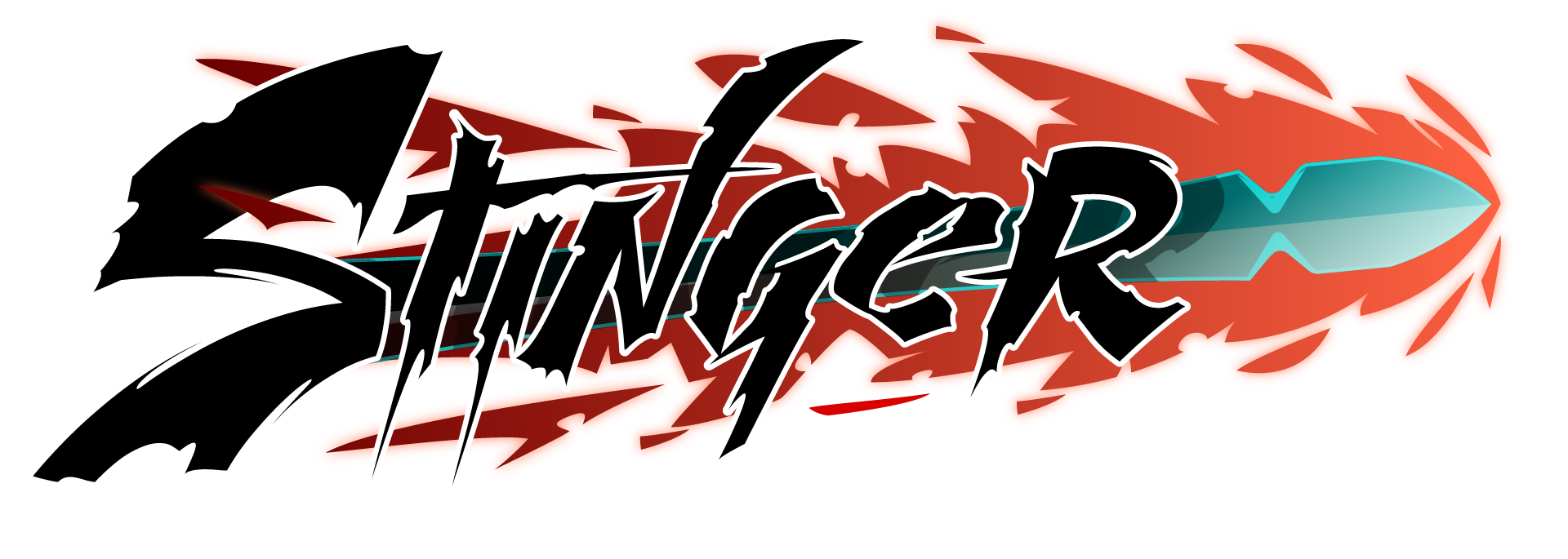
Good job Roy. Nice gif and image uses.
Cheers man! Glad you liked the article 🙂
This game, as well as Devil May Cry, ruined gaming for me because of the concepts they brought to the table. When an ex got me into World of Warcraft way back in the day, my only thought was "why isn't this combat like DMC?". Similarly, when I played Gears of War, I despised it for being slow and clunky unlike Vanquish. I think the only other shooters to scratch the itch Vanquish left are Titanfall 2, Lawbreakers, and Warframe, but even then, none of them compare to the legacy of Vanquish.
It will take a lot of effort and finesse of a developer to ever make something that will beat Vanquish in my book. I know how you feel on this. Great article, great game, and now I need to go beat it again.
Cheers man! Vanquish really is that next level of shooters. If you haven't already, Max Payne 3 is really worth it. If Vanquish is Devil May Cry 3, then Max Payne 3 is Ninja Gaiden Black – if you catch my drift. Very defensive game, but highly enjoyable and well put together.
Should be noted that an end-game Warrior in vanilla WoW was basically DMC3 Dante in terms of complexity, that stuff could get really bonkers with stance-dancing etc. Here's hoping the classic servers come soon!
You can push your own grenades with the LFE?!?! Vanquish has been a favorite of mine for years, and I never knew that!
Yeah the LFE is just such a genius weapon with what you can do with it. I wouldn’t be surprised if new tech is found in the future.